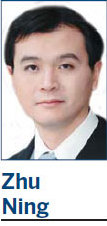Big steps must follow small advances
Updated: 2013-10-18 08:55
By Zhu Ning (China Daily Europe)
|
|||||||||||

Policymakers must take more concerted steps to make the renminbi a global currency
The BOC Cross-Border RMB Index launched by the Bank of China in Singapore last month is a big step in China's efforts to internationalize the renminbi, as it is the first index on renminbi internationalization compiled and maintained by a Chinese financial institution.
According to officials, the index will help track cross-border renminbi flows and transactions over time and across different regions. In particular, the gauge will follow the fluctuations in the amount of cross-border renminbi flows, including renminbi flow into and out of China, and cross-border transactions outside China.
The Bank of China says the index climbed to 186 in the second quarter of this year, registering an increase of 41 percent from the second quarter of last year, and an 86 percent increase over the fourth quarter of 2011, when the index started. Despite the index's rapid growth in the past couple of years, such a trend has come to a halt this year. As a matter of fact, the index has dropped slightly from the first quarter of this year, which is partly reflected in the capital outflows in response to the tapering off of the US Federal Reserve's asset purchase (quantitative easing) programs.
Such a drop or even stalling in the progress of renminbi internationalization prompted some concerns over China's determination in making the renminbi an international currency. On the other hand, others point out that China has made tremendous headway in pushing the use of renminbi around the globe.
The differences of opinion probably come from two very different perspectives on the progress of renminbi internationalization. The Bank of International Settlement says the average daily trading volume of renminbi reached $120 billion last year, dozens of times greater than $3.4 billion in 2010. This makes the renminbi one of the top 10 most actively traded currencies in the entire world.
On the other hand, even after such rapid growth, the Chinese currency has not garnered international acceptance similar to "made in China" products. Foreign trade cleared in renminbi accounted for about 0.87 percent of the total global foreign trade last year, in stark contrast with the fact that China makes up about 10 percent of total foreign trade in the world.
As a result, many expect increasing internationalization of the Chinese currency as the country's economy becomes more open and integrated into the global economic and trade system.
However, there remains considerable speculation about what China really wants to achieve in its attempt to internationalize the renminbi. According to monetary theory, currencies typically play three related yet distinct roles, namely as intermediaries for global trade, vehicles for international investment and clearing, and as reserve holdings in central banks' reserve systems.
By such criteria, the renminbi seems to have only achieved part of the first criterion. As renminbi has become used in a wider range of business transactions and greater trade volume, it has definitely ascended in its status as an international currency. In this regard, the internationalization of the renminbi has naturally sped up, especially in the Asian and Pacific regions, due to close trade ties and China's greater influence in the region. Though Hong Kong has taken a clear lead in its attempt to become an overseas renminbi center, Singapore and Taipei have also extended their exposure to renminbi, both in trades and in investment.
What seems to be falling short of the Chinese government's expectation is the other two functions of an international currency, namely investment currency and reserve ballast.
If one were to use foreign exchange market turnover as an indicator of a currency's potential as a vehicle currency for transactions involving cross-border financial transactions, then a totally different picture emerges for the renminbi. At about 1 percent of all the turnover in foreign exchange markets in 2011, the renminbi trails the currencies of many other countries, even other Asian countries with much smaller economies.
Along with China's ambition to turn the renminbi into a major investment currency, there are other deeper concerns and considerations. Having witnessed the volatile financial markets during the global financial crisis and how the prices of commodities, shipping, and energy can determine the power of a specific currency and its issuing country, China feels increasingly compelled to command similar power that is currently being enjoyed by the US, the EU, and Japan.
China's wish to eventually turn the renminbi into a global reserve currency is also partly related to China's increasing dissatisfaction with the current global monetary system. Although perhaps an even longer shot than the previous two functions, the role of a reserve currency may indeed be something that Chinese government truly seeks in renminbi internationalization after all. With $3 trillion worth of foreign exchange reserves, mostly invested in the US Treasury and US government agency securities, China has become increasingly worried about the safety and valuation of its ballooning foreign reserves. Therefore, China is looking to make the renminbi an equal alternative, when various countries decide what to hold in their respective foreign reserves.
Given Chinese economic growth and increasing power in the global arena, such ambitions are not only understandable, but also reasonable. That said, it is equally important that people remain realistic with their expectations, and challenges that they may face.
History teaches that there was a long lag between when the US economy supassed the UK economy in size and when the dollar overtook sterling as a major international currency, according to research in international economics and economic history. Even with its economy close to the level of the US in the 1980s, Japan has tried, and failed to make the Japanese yen a leading international currency, let alone a dominant one. Hence, both Chinese government and international investors have to be realistic and patient with the duration of this process.
In addition, the renminbi internationalization has to take place at a pace compatible with other reforms in the Chinese financial sector, most notably the liberalization of interest rate and renminbi exchange rate, and the full convertibility of renminbi into and out of China. The controls on renminbi convertibility limit foreigner's interests and motivation in getting into the market and holding renminbi assets. Regulated interest rate and exchange rate results in additional risks that may deter certain investors.
Finally, the internationalization of the renminbi may lead to further reforms in China, which is yet another key motivation for renminbi internationalization often neglected by the rest of the world. With the renminbi becoming more widely accepted by foreign countries and foreign investors, the determination of the Chinese currency, its cross border flows, and investment products and markets denominated in the renminbi, would all gradually gravitate toward international standards and practices.
As the renminbi becomes more and more international, the Chinese domestic financial system, capital flow regulation, and interest rate and exchange rate liberalization, will all evolve into a brand new stage of reform.
In this sense, despite the importance of renminbi internationalization's ultimate goal, the process itself is probably just as valuable and instrumental to China's attempt to become more international and to change its economic growth model at this critical junction.
The author is a faculty fellow at the International Center for Finance, Yale University; and deputy director of the Shanghai Advanced Institute of Finance, Shanghai Jiaotong University. The views do not necessarily reflect those of China Daily.
(China Daily European Weekly 10/18/2013 page10)
Today's Top News
Scientists requested government to plant GM crops
Travelers to Europe bypass attractions of Brussels
Li urges greater effort on reforms
'Constructive ideas' on thorny issues needed
US deal key to nabbing fugitives
JPMorgan, DOJ reaches $13b deal
As China's economy grows, so does reform call
Expanded property tax trials predicted
Hot Topics
Lunar probe , China growth forecasts, Emission rules get tougher, China seen through 'colored lens', International board,
Editor's Picks

|

|

|

|

|

|





